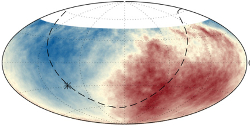HEAPOW: Mysterious Travelers from Beyond the Milky Way (2017 Sep 25)
Posted: Mon Sep 25, 2017 3:04 pm
 HEAPOW: Mysterious Travelers from Beyond ... (2017 Sep 25)
HEAPOW: Mysterious Travelers from Beyond ... (2017 Sep 25)
Cosmic rays are broken bits of atoms traveling near the speed of light which rain down on the earth from outer space. These positively-charged atomic nuclei are accelerated to extreme energies by powerful processes which have not yet been fully identified nor understood. Particularly mysterious are the ultra-high energy cosmic rays, particles that are accelerated to energies a million times higher than can be produced by the Large Hadron Collider (the most powerful particle accelerator ever built). Some of these atomic nuclei carry as much kinetic energy as a well-struck tennis ball. When these ultra-high energy particles hit the top of the earth's atmosphere, they produce billions of secondary particles (electrons, protons and muons). These particles can be detected in large tanks of water through the Cherenkov radiation they produce as they travel through the water at speeds faster than the local speed of light. The Pierre Auger Observatory, the largest ultra-high energy cosmic ray detector, is a collection of 1600 water tanks, along with 24 optical telescopes, distributed over 3,000 square kilometers in Argentina. The Auger Collaboration has now discovered an anisotropy in the distribution of 30,000 detected cosmic rays on the sky. The Auger observations show that more cosmic rays are detected from a particular spot on the sky, which is shown by the reddish spot in the all-sky map of cosmic rays shown above. This spot seems to be associated with a region where the number of external galaxies is relatively high. Perhaps these particles are produced somehow near supermassive black holes at the centers of some galaxies, but individual sources of these ultra-high energy cosmic rays still have not been identified.
From galaxies far far away!
http://asterisk.apod.com/viewtopic.php?t=37599
| << Previous HEAPOW | High Energy Astrophysics Picture of the Week | Next HEAPOW >> |